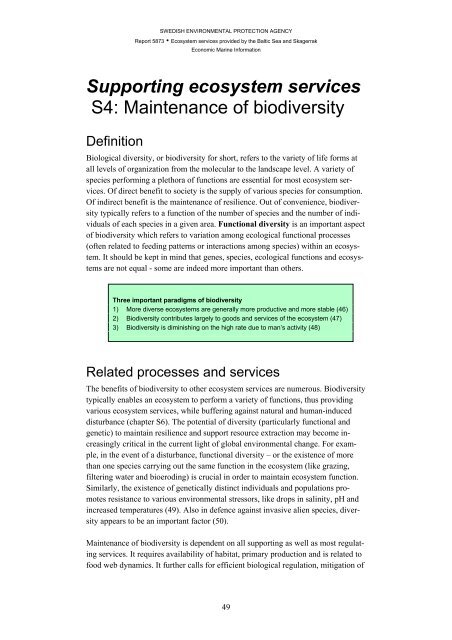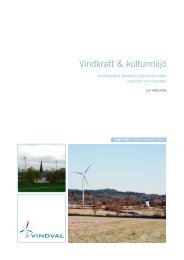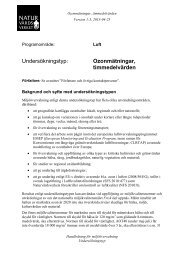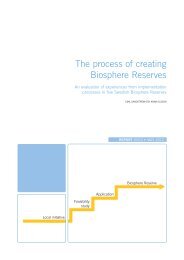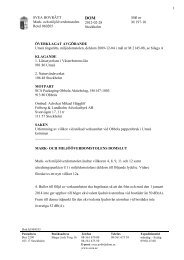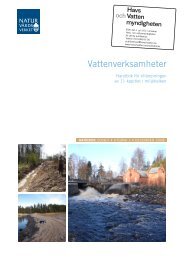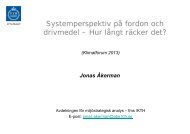Ecosystem services provided by the Baltic Sea ... - Naturvårdsverket
Ecosystem services provided by the Baltic Sea ... - Naturvårdsverket
Ecosystem services provided by the Baltic Sea ... - Naturvårdsverket
Create successful ePaper yourself
Turn your PDF publications into a flip-book with our unique Google optimized e-Paper software.
SWEDISH ENVIRONMENTAL PROTECTION AGENCY<br />
Report 5873 • <strong>Ecosystem</strong> <strong>services</strong> <strong>provided</strong> <strong>by</strong> <strong>the</strong> <strong>Baltic</strong> <strong>Sea</strong> and Skagerrak<br />
Economic Marine Information<br />
Supporting ecosystem <strong>services</strong><br />
S4: Maintenance of biodiversity<br />
Definition<br />
Biological diversity, or biodiversity for short, refers to <strong>the</strong> variety of life forms at<br />
all levels of organization from <strong>the</strong> molecular to <strong>the</strong> landscape level. A variety of<br />
species performing a plethora of functions are essential for most ecosystem <strong>services</strong>.<br />
Of direct benefit to society is <strong>the</strong> supply of various species for consumption.<br />
Of indirect benefit is <strong>the</strong> maintenance of resilience. Out of convenience, biodiversity<br />
typically refers to a function of <strong>the</strong> number of species and <strong>the</strong> number of individuals<br />
of each species in a given area. Functional diversity is an important aspect<br />
of biodiversity which refers to variation among ecological functional processes<br />
(often related to feeding patterns or interactions among species) within an ecosystem.<br />
It should be kept in mind that genes, species, ecological functions and ecosystems<br />
are not equal - some are indeed more important than o<strong>the</strong>rs.<br />
Three important paradigms of biodiversity<br />
1) More diverse ecosystems are generally more productive and more stable (46)<br />
2) Biodiversity contributes largely to goods and <strong>services</strong> of <strong>the</strong> ecosystem (47)<br />
3) Biodiversity is diminishing on <strong>the</strong> high rate due to man’s activity (48)<br />
Related processes and <strong>services</strong><br />
The benefits of biodiversity to o<strong>the</strong>r ecosystem <strong>services</strong> are numerous. Biodiversity<br />
typically enables an ecosystem to perform a variety of functions, thus providing<br />
various ecosystem <strong>services</strong>, while buffering against natural and human-induced<br />
disturbance (chapter S6). The potential of diversity (particularly functional and<br />
genetic) to maintain resilience and support resource extraction may become increasingly<br />
critical in <strong>the</strong> current light of global environmental change. For example,<br />
in <strong>the</strong> event of a disturbance, functional diversity – or <strong>the</strong> existence of more<br />
than one species carrying out <strong>the</strong> same function in <strong>the</strong> ecosystem (like grazing,<br />
filtering water and bioeroding) is crucial in order to maintain ecosystem function.<br />
Similarly, <strong>the</strong> existence of genetically distinct individuals and populations promotes<br />
resistance to various environmental stressors, like drops in salinity, pH and<br />
increased temperatures (49). Also in defence against invasive alien species, diversity<br />
appears to be an important factor (50).<br />
Maintenance of biodiversity is dependent on all supporting as well as most regulating<br />
<strong>services</strong>. It requires availability of habitat, primary production and is related to<br />
food web dynamics. It fur<strong>the</strong>r calls for efficient biological regulation, mitigation of<br />
49


